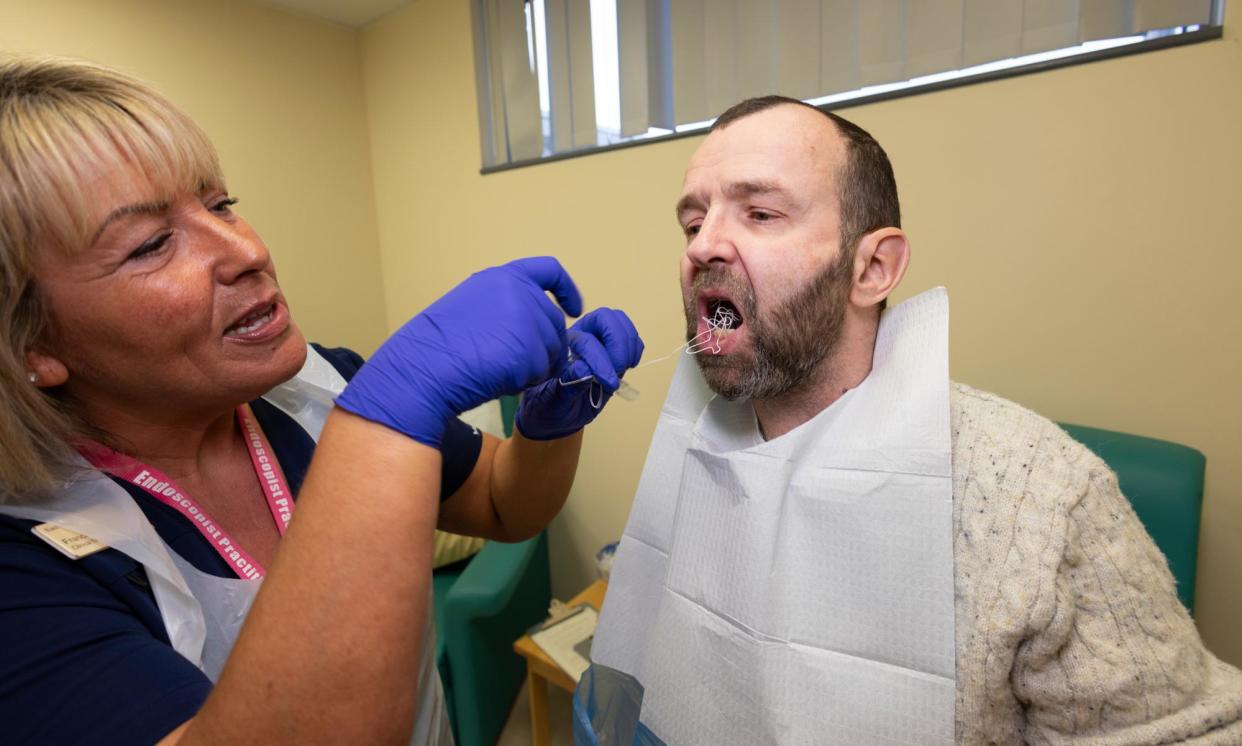Sponge on a string reduces long waits for diagnostic test for cancer

A “sponge on a string” used to identify a precursor to one of Britain’s deadliest cancers is helping to reduce the long delays faced by patients who need a vital diagnostic test.
An NHS trial of the innovative “cytosponge” has found that almost eight out of 10 people who are assessed using the method do not then need to join the waiting list for an endoscopy.
About 8,500 patients in England have so far been tested using the cytosponge, a capsule the size of a tablet which, when washed down with a glass of water, expands in the stomach. It is then pulled out using the attached thread, allowing the cells it has gathered to be analysed to see if someone has Barrett’s oesophagus, which raises the risk of developing oesophageal cancer.
Oesophageal cancer – cancer of the food pipe – is on the rise and is closely associated with risk factors such as poor diet, smoking, alcohol consumption and having a hiatus hernia.
NHS England’s evaluation of 2,550 of those 8,500 patients found that 78% of them did not have Barrett’s oesophagus and could in future be managed by their GP rather than undergoing an endoscopy.
The test, which involves putting a tiny camera into someone’s body, is a key way of diagnosing a number of forms of cancer, such as colon and stomach cancer.
Only 22% of those tested using the sponge who were found to be at higher risk of the condition needed to have an endoscopy, which in turn is giving higher-risk suspected cancer patients speedier access to one.
Experts say the new method could reduce the number of people diagnosed late with oesophageal cancer, which is the fourth-biggest cancer killer in men and seventh largest in women.
About 9,300 people a year in the UK are diagnosed with the disease and 8,000 – 22 a day – die from it, said Cancer Research UK (CRUK). Only 12% of those diagnosed survive for 10 years.
NHS England has been undertaking the sponge test in 30 hospitals since 2021. It has generated a lot of interest because it takes far less time than an endoscopy, is far less invasive and quicker to access, and is £300 cheaper a time for the NHS to carry out.
“Thousands of people have now benefited from this incredibly efficient test on the NHS. While the sponge on a string is small in size, it can make a big difference for patients,” said Amanda Pritchard, NHS England’s chief executive.
The Lister hospital in Stevenage is one of 30 hospitals piloting the test.
Danielle Morris, a consultant gastroenterologist at the hospital, said that 670 of the first 1,000 patients who had the sponge test did not need a gastroscopy – the type of endoscopy traditionally used to check for Barrett’s oesophagus.
She said: “That’s good for patients because those who did need an endoscopy got it quicker, because a large number of patients who didn’t need to be on the routine waiting list were removed from it.”
It has helped the Lister cut endoscopy waiting times, which were many months long during Covid, to between six and eight weeks, she added.
Patients who have the sponge test receive it within three weeks of being referred by a GP and get their result two or three weeks later.
In England, 99% of patients should undergo an endoscopy within six weeks of referral. However, 35% of the 179,000 people on the endoscopy waiting list in December had already been waiting for longer than that, according to analysis of NHS data by CRUK, which helped fund the sponge’s development.
Dr Lyndsy Ambler, the charity’s senior strategic evidence manager, said: “The capsule sponge test has become one of the most exciting early detection tools to emerge in recent years.
“This evaluation adds to the evidence showing that it is helping the NHS to free up endoscopy capacity and could lead to improvements in reducing late diagnosis of oesophageal cancer.”


